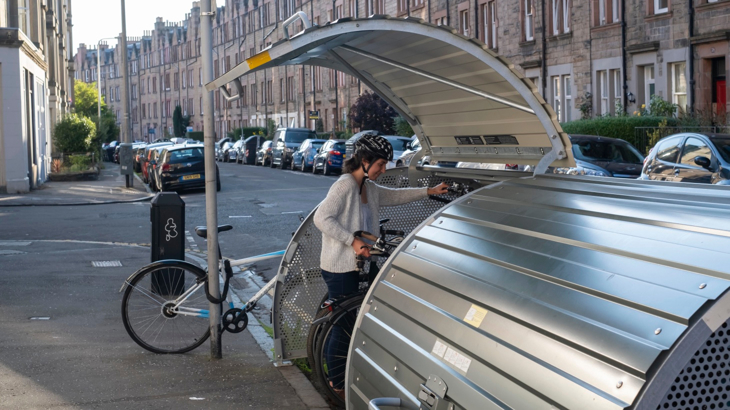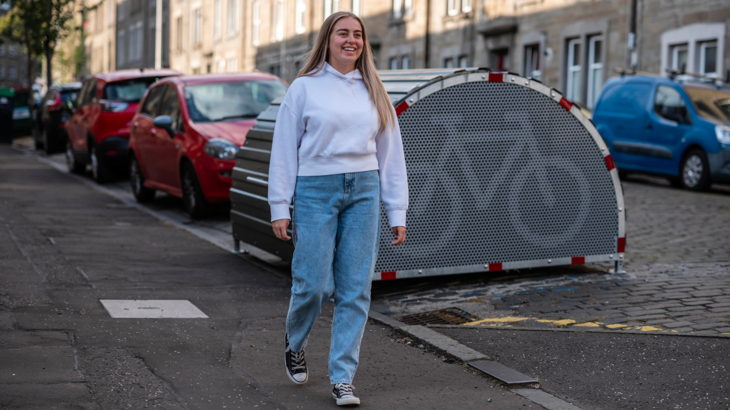We believe cycling and its benefits for health, the environment and accessing the things you need to live well should be an opportunity for everyone. This means overcoming barriers, including a lack of access to secure, accessible cycle parking at home. Our research, generously funded by Cyclehoop, unveils how poor cycle parking stops people on a low income or not in employment from cycling and what can improve it.

If people do not have a place to park a cycle at home that is convenient, accessible and secure, they are less likely to take up cycling. Credit: Brian Sweeney
Why improve residential cycle parking?
1. Limited transport choices are holding back many people on low incomes
People on a low income or not in employment are less likely to own a car, and for those who do, rising living costs are making it unaffordable to run.
For those reliant on public transport, prohibitive train fares and cuts to bus services have restricted their ability to travel.
A lack of transport options puts people at risk of losing their job or prevents them from accessing work, education, health and care services.
This has negative consequences for our health and the economy.
2. Cycling can help increase transport choices
There are similar disparities when it comes to owning a cycle.
A cycle can open up opportunity and is a low-cost form of transport for many everyday journeys.
31% of people living in households on a low income don’t currently cycle but want to start.
3. People need secure and accessible cycle parking at home
If people do not have a place to park a cycle at home that is convenient, accessible and secure, they are less likely to take up cycling.
With this in mind, we set out to better understand residential cycle parking provision for people on a low income or not in employment across the UK and how it could be improved.

Nicky, Oldbury, West Midlands
With my condition I struggle to walk long distances. With cycling, it’s not hard on your joints so I think having secure storage to get my own bike would open up a lot up for me.
I would consider getting storage on my drive at the front of my house – as long as it’s good quality, lockable and easy to get bikes in and out.
Either that or street storage is really appealing, there’s so much space around here - it would benefit the rest of the community too.
As part of our investigation, Sustrans set out to:
- understand residential cycle parking provision for people on a low income or not in employment across the UK
- understand what people on a low income or not in employment require from residential cycle parking to meet their needs.
What we found
Our residential cycle parking survey found only 12% of people on a low income or not in employment own a cycle and currently use it.
We also found that just under a third (32%) of people on a low income or not in employment did not have a convenient and secure space to park their cycle at home.
This equates to 3.7 million people who are locked out of cycling, despite being those who need it most.
Disparities in access to cycle parking are even starker for many on a low income or not in employment.
39% of disabled people did not have convenient and secure space to park their cycle at home, as well as 34% of women and 36% of people from an ethnic minority background.
Almost half of people on a low income or not in employment (47%) said they would start cycling or cycle more if they had a place to park their cycle at home which was convenient, secure, safe, and accessible. This equates to around 5.5 million people.
This is a particularly important issue for people living in flats.
For example, people who live in a flat are far less likely to have a secure (27%) or accessible (23%) place to store a cycle than people who live in a detached house (60% and 58% respectively).
Security is an important factor for cycle parking, especially in areas of multiple deprivation.
15% of respondents had their own or knew someone who had had their cycle stolen from where they lived in the past 12 months.
Accessibility is critical
Two in five people on a low income or not in employment identify as having a long-term health condition or disability.
Residential cycle parking must be designed to be inclusive of those who need more expensive specialised cycles, including e-cycles, hand cycles and recumbent cycles.
5.5 million people
could start cycling or would cycle more if they had convenient, secure, safe and accessible cycle storage.
3.7 million people
are locked out of cycling as they don't have a convenient and secure space to park their cycle at home.

Our residential cycle parking survey found only 12% of people on a low income or not in employment own a cycle and currently use it. Credit: Brian Sweeney
Our three recommendations:
1. Local authorities should increase residential parking provision, prioritising flats and areas of deprivation
- Local authorities and housing associations should provide communal cycle parking for flats and in areas of deprivation.
- Local authorities and housing associations should increase awareness of confidence to use residential cycle parking amongst local communities and tenants’ groups.
2. Governments across the UK should put in place standards, investment and regulations to improve residential cycle parking
- This includes strengthening guidance for all local authorities to improve residential cycle parking provision.
- Ensure local authorities have access to long-term funding for sustainable transport that can be used to improve residential cycle parking.
- Reform planning regulations to ensure all new homes have access to adequate cycle parking.
- Amend permitted development rights for householders to allow the installation of cycle stores at the front (principle elevation) of houses and flats.
3. Governments across the UK and local authorities should work together to tackle other barriers to cycling for people on a low income or not in employment
- Local authorities should audit and improve public cycle parking.
- Governments across the UK should provide financial support to people on a low income or not in employment to buy a cycle.
- Governments across the UK need to work together with local authorities to improve cycling infrastructure.

If people do not have a place to park a cycle at home that is convenient, accessible and secure, they are less likely to take up cycling. Credit: Brian Sweeney
Download the Residential cycle parking report

With thanks to Cyclehoop for generously funding and supporting this research.





